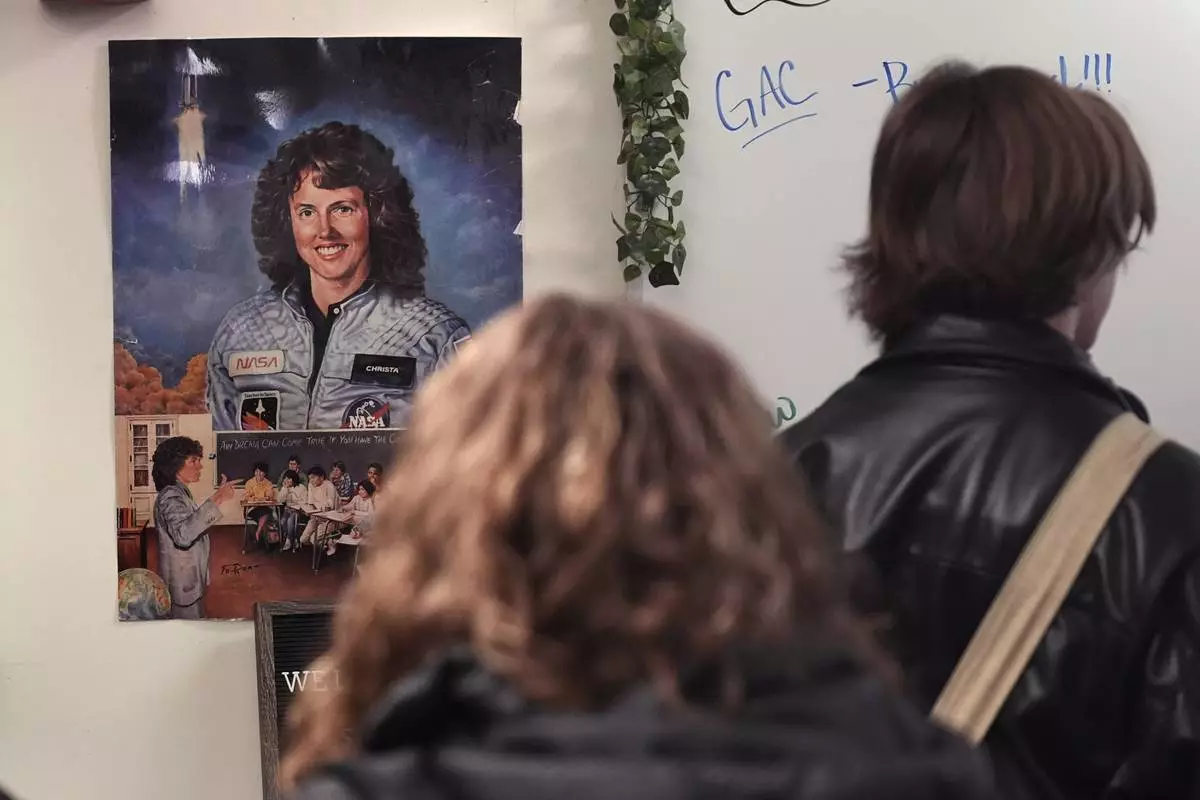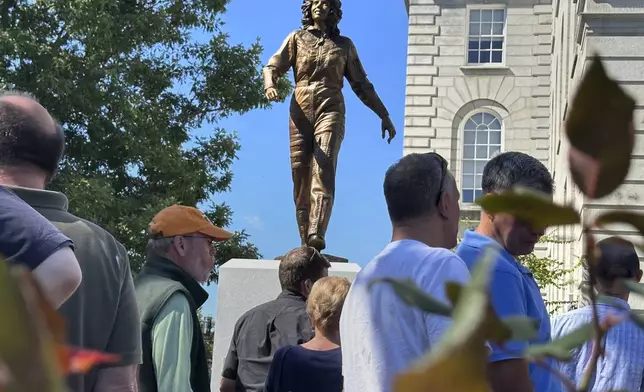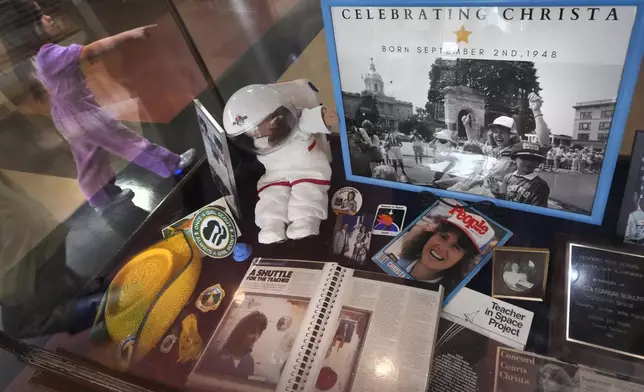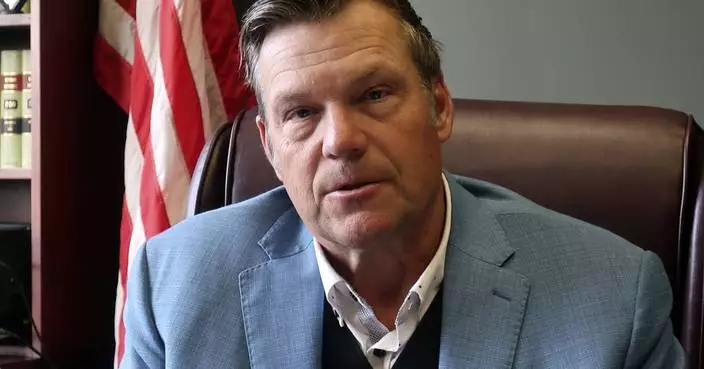CONCORD, N.H. (AP) — Before Christa McAuliffe was an astronaut, she was a vibrant teacher in New England keen on showing her students how everyday people left extraordinary marks on U.S. history.
Nearly four decades later, a new documentary focuses on how she still inspires others and less on her fate aboard the space shuttle Challenger.
Click to Gallery
A crowd surrounds the newly-unveiled statue of Christa McAuliffe, NASA's first teacher in space, outside the Statehouse, Monday, Sept. 2, 2024, in Concord, N.H. (AP Photo/Holly Ramer, File)
A student passes a selection of memorabilia featuring Christa McAuliffe, NASA's first teacher in space, is displayed at the McAuliffe-Shepard Discovery Center, Monday, Dec. 16, 2024, in Concord, N.H. (AP Photo/Charles Krupa)
With a poster of NASA's first teacher in space Christa McAuliffe displayed on the wall, teacher Kimberly Bleier instructs her students in one of classrooms where McAuliffe taught at Concord High School, Monday, Dec. 16, 2024, in Concord, N.H. (AP Photo/Charles Krupa)
The space shuttle Challenger is destroyed shortly after lifting off, Tuesday, Jan. 28, 1986, at the Kennedy Space Center in Florida. The crew of seven, including NASA's first teacher in space Christa McAuliffe, died in the explosion. (AP Photo/Bruce Weaver, File)
With a poster of NASA's first teacher in space Christa McAuliffe displayed on the wall, students head to their next period class from one of classrooms where McAuliffe taught at Concord High School, Monday, Dec. 16, 2024, in Concord, N.H. (AP Photo/Charles Krupa)
Christa McAuliffe, NASA's first teacher in space, smiles after she was suited up for her space flight, Jan. 27, 1986, at the Kennedy Space Center in Florida. (NASA via AP, File)
A model of the space shuttle Challenger, at right, floats above a portrait of NASA's first teacher in space Christa McAuliffe at the McAuliffe-Shepard Discovery Center, Monday, Dec. 16, 2024, in Concord, N.H. (AP Photo/Charles Krupa)
A selection of memorabilia featuring Christa McAuliffe, NASA's first teacher in space, is displayed at the McAuliffe-Shepard Discovery Center, Monday, Dec. 16, 2024, in Concord, N.H. (AP Photo/Charles Krupa)
Christa McAuliffe, NASA's first teacher in space, rides with her children Caroline and Scott past the Statehouse during a parade, Saturday, July 21, 1985 in Concord, N.H. (AP Photo/Jim Cole, File)
“Christa: From Ordinary to Extraordinary” from New Hampshire PBS explores her close relationship with the state and its capital, Concord, where she was picked from more than 11,000 applicants to be the nation’s first teacher in space.
“You say ‘Christa’ in New Hampshire, everyone knows exactly who you’re talking about,” Gov. Chris Sununu says in the film. Its release on Thursday comes three months after a bronze statue of McAuliffe was unveiled at the Statehouse, on what would have been her 76th birthday.
The documentary features interviews with community members, footage of scenes such as a Main Street parade for McAuliffe, and some of her comments — including her parting speech to Concord High School seniors in 1985. It reflects the pride and joy felt by residents then and now for an enthusiastic teacher who loved learning and telling stories.
McAuliffe was 37 when she was killed, one of the seven crew members aboard the Challenger when the space shuttle broke apart on live TV on Jan. 28, 1986. The documentary briefly touches on the tragedy.
“We all want to be remembered for who we were, what we cared about, what we loved, what we did, and not how we died,” Jeanne Gerulskis, the recently retired executive director of the McAuliffe-Shepard Discovery Center, says in the film.
McAuliffe taught social studies at Concord High School beginning in 1983. She created a course devoted to the history of American women that's still taught there today. People in the documentary said she wanted students to see the role that ordinary people, particularly women, can play in history.
McAuliffe saw herself as one of them. A lover of field trips, she looked forward to bringing back her thoughts and journal from the shuttle mission “like a woman on the Conestoga wagon pioneering the West,” she had said in an interview.
Holly Merrow, a former student of McAuliffe's in the women's history class, feels the documentary embodies her spirit of wanting to inspire children.
“We felt like we were going to space, as well,” Merrow, now a teacher in Maine, recalled about McAuliffe at a recent screening of the film.
The documentary also talks about the importance of telling children who McAuliffe was.
In New Hampshire, many children learn about government beginning in fourth grade. They visit the Statehouse. McAuliffe's statue stands near the entrance, a good starting point for a discussion. It's the first statue added to the grounds in over a century, and the first woman.
At Concord High School, Kimberly Bleier teaches social studies in a room where McAuliffe once taught. In the film, she says she often reminds herself that “there’s a lot of responsibility there” to ensure that what McAuliffe brought to the school, such as her love of hands-on learning, is still remembered and talked about.
Bleier currently teaches “Street Law,” a general introduction to the legal system that emphasizes criminal and juvenile law. McAuliffe had taught that class, too.
Bleier was a sixth-grader when she watched the space shuttle launch on television. She recalled how devastating it was.
“I don't want to watch the shuttle blow up again,” she said in an interview with The Associated Press on Monday. “I want to watch her. I want to hear her.”
The 30-minute documentary can be viewed online on the New Hampshire PBS website. Viewers also can stream it on the PBS App.

A crowd surrounds the newly-unveiled statue of Christa McAuliffe, NASA's first teacher in space, outside the Statehouse, Monday, Sept. 2, 2024, in Concord, N.H. (AP Photo/Holly Ramer, File)

A student passes a selection of memorabilia featuring Christa McAuliffe, NASA's first teacher in space, is displayed at the McAuliffe-Shepard Discovery Center, Monday, Dec. 16, 2024, in Concord, N.H. (AP Photo/Charles Krupa)

With a poster of NASA's first teacher in space Christa McAuliffe displayed on the wall, teacher Kimberly Bleier instructs her students in one of classrooms where McAuliffe taught at Concord High School, Monday, Dec. 16, 2024, in Concord, N.H. (AP Photo/Charles Krupa)

The space shuttle Challenger is destroyed shortly after lifting off, Tuesday, Jan. 28, 1986, at the Kennedy Space Center in Florida. The crew of seven, including NASA's first teacher in space Christa McAuliffe, died in the explosion. (AP Photo/Bruce Weaver, File)

With a poster of NASA's first teacher in space Christa McAuliffe displayed on the wall, students head to their next period class from one of classrooms where McAuliffe taught at Concord High School, Monday, Dec. 16, 2024, in Concord, N.H. (AP Photo/Charles Krupa)

Christa McAuliffe, NASA's first teacher in space, smiles after she was suited up for her space flight, Jan. 27, 1986, at the Kennedy Space Center in Florida. (NASA via AP, File)

A model of the space shuttle Challenger, at right, floats above a portrait of NASA's first teacher in space Christa McAuliffe at the McAuliffe-Shepard Discovery Center, Monday, Dec. 16, 2024, in Concord, N.H. (AP Photo/Charles Krupa)

A selection of memorabilia featuring Christa McAuliffe, NASA's first teacher in space, is displayed at the McAuliffe-Shepard Discovery Center, Monday, Dec. 16, 2024, in Concord, N.H. (AP Photo/Charles Krupa)

Christa McAuliffe, NASA's first teacher in space, rides with her children Caroline and Scott past the Statehouse during a parade, Saturday, July 21, 1985 in Concord, N.H. (AP Photo/Jim Cole, File)
BUDAPEST, Hungary (AP) — Moving in a dense cloud, like throngs of people walking across a crowded public square, 100 drones maneuver through the night sky in Hungary's capital, the result of over a decade of research and experimentation that scientists believe could change the future of unmanned flight.
The behavior of the swarm, made up of autonomous drones that make their own real-time decisions on collision avoidance and trajectory planning without pre-programming or centralized control, is guided by research the Hungarian scientists performed on the collective movements of creatures from the natural world.
“It’s very rare that you see some technology and you say it’s beautiful,” said Boldizsár Balázs, one of the researchers working on the project. "In its theoretical core it resembles nature. That’s why the drones themselves don’t need to be pretty, but what they do is pretty because it resembles natural swarming behavior.”
Drones have in recent years become a common sight in our skies: Companies like Amazon and FedEx have launched drone delivery services, hobbyists use them for aerial photography and groups of over 1,000 drones have been pre-programmed to deliver large-scale light shows.
But the scientists at the Eötvös Loránd University in Budapest have developed new models based on animal behavior that allow a large number of drones to travel autonomously, reacting in real time to their environment and each other as they coordinate individual routes and tasks in dense aerial traffic.
“This is the level we call decentralization ... After the drones are told what to do, we can switch off the ground control station, we can burn it or whatever, throw it away,” said Gábor Vásárhelyi, a senior researcher at the university's Department of Biological Physics. “The drones will be able to do what they have to do just by communicating to each other.”
Using data they gathered by monitoring the behavior of pigeons in flight, the patterns of wild horses in the Great Hungarian Plain and other animal movements, they developed an algorithm that allows the drones to make on-board, autonomous decisions, safely mitigating conflicts and avoiding collisions.
While such technology has the potential to increase efficiency across many fields, some researchers have voiced concerns that certain applications of autonomous drones could pose significant dangers.
Anna Konert and Tomasz Balcerzak with the Faculty of Law and Administration at Lazarski University in Warsaw, Poland, have researched such risks, and warn that military applications could escalate arms races or be misused or hacked by malign actors such as terrorist groups.
“When drones take over lethal actions, responsibility may shift from human operators to machines, leading to uncertainty about who should be held accountable if errors occur,” they wrote in an email. “This detachment could lower the psychological barriers to initiating force, potentially making war more frequent and brutal.”
They also write that autonomous drones reducing the human cost of military engagements could “encourage more frequent military actions, leading to faster conflict escalation since fewer immediate human consequences would weigh against the decision to engage militarily.”
But beyond military uses, the researchers in Hungary say their technology has the potential to improve people's lives through numerous other applications.
Their digital simulations in three dimensions have them convinced that their algorithm can be scaled up to support 5,000 drones flying together autonomously, which they say could have applications in meteorology, land surveying, goods deliveries and beyond.
The researchers are also working on rolling out an agricultural application that can be used for the precision spraying of crops, and believe the technology could also play a role in decentralizing air traffic control systems as more and more unmanned aircraft take to the skies.

This handout photo long exposure shot shows the flight of a flock of autonomous drones during an experiment near Budapest, Hungary, Thursday, Oct. 21, 2021. (AP Photo/HO/Eotvos Lorand University)

This handout photo taken with long exposure shows a researcher of the Eötvös Loránd University observing the flight of a flock of autonomous drones during an experiment near Budapest, Hungary, Thursday, Oct. 21, 2021. (AP Photo/HO/Eotvos Lorand University)

This handout photo taken with long exposure shows a researcher of the Eötvös Loránd University observing the flight of a flock of autonomous drones during an experiment near Budapest, Hungary, Thursday, Oct. 21, 2021. (AP Photo/HO/Eotvos Lorand University)

In this handout photo Gabor Vasarhelyi, physicist and researcher of the Department of Biological Physics at Eötvös Loránd University, is using his computer to set a swarm of 100 quadcopters to fly autonomously during an experiment near Budapest, Hungary, Thursday, Oct. 21, 2021. (AP Photo/HO/Eotvos Lorand University)

In this handout photo Gabor Vasarhelyi, physicist and researcher of the Department of Biological Physics at Eötvös Loránd University, is using his computer to set a swarm of 100 quadcopters to fly autonomously during an experiment near Budapest, Hungary, Thursday, Oct. 21, 2021. (AP Photo/HO/Eotvos Lorand University)
































